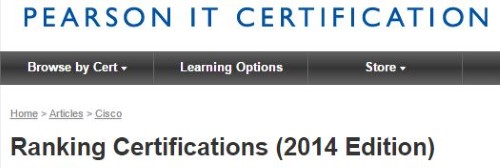Revising “Ranking Certs” for 2016 by Ed Tittel
For those of you who don’t already know, we’ve re-created my print book entitled “IT Certification Success” (which appeared in 5 paper editions between 1999 and 2005) as an e-book right here at PITC. It’s available through “Ed Tittel’s IT Certification Success” any time you’d care to check it out. One of its most popular features is called “Ranking Certifications” wherein we apply a series of metrics to compare over 100 IT certifications by level of difficulty, time required for completion, number of exams involved, out of pocket cost, background and experience required, and average pay for certifications holders. We’ve just finished updating this massive research effort and for today’s blog, I want to report on what changed since this ranking was last updated in 2014.
For the 2014 set of rankings, we included 89 credentials from 34 sponsors; for the 2016 replacement, we included 101 credentials from a similar number of sponsors. Along the way, we eliminated 10 old, obsolete (or suspect) credentials, and added 22 new ones. But that doesn’t tell the whole story: we initially added all of the items we identified in the “Top 5 Certs” stories we also update annually for Tom’s IT Pro that weren’t already on this list. This got our total of items up over 160 to begin with, after which I had to whittle away at that list to remove enough items to bring the total down to as close to 100 — our target level of coverage — as I could get. This took some time, soul-searching, and effort, and I wanted to share with you some of the criteria that I applied to chop, chop, chop away at that 160-plus figure:
- When we do the Tom’s stories, we identify IT niches where certifications are available, and then proceed to dig up the Top 5 credentials for each such niche. As it turns out, even though all of the certs we choose are valuable in their own areas and arenas, some of those niches are quite small (we total up job postings that make mention of them on numerous websites to get a rough-and-ready measure of their popularity and reach). For some niches, the totals across all sites fall well under 100; for other, more popular niches, those totals may exceed 20,000. Given such a wide swing in values, I decided to choose the more popular and well-known credentials over less popular and more obscure ones.
- Some of the certifications are so expensive and time-consuming that they throw our metrics something of a curveball. Thus, for example, we don’t include the popular and valuable SAP credentials in our list for 2016, nor did the Cisco Certified Architect make the cut, either. Their metrics routinely exceed 200 and completely swamp everything else in our selected population. Because these certs serve relatively small populations, we keep them out — again, to concentrate on more popular and widely-pursued IT credentials.
- Given a choice between popular, widely followed, and relatively valuable credentials that are destined for obsolescence or replacement in the next year or two, versus their less popular, less widely followed but no-doubt equally valuable replacement credentials, we chose the latter to give our rankings a longer shelf life. That’s why, for example, you see that the 2016 Rankings concentrate on the new VCP6 credentials from VMware, while cheerfully ignoring the VCP5 stuff — VCP5 certs will retire in 2016, so they simply won’t be available for the foreseeable life of those rankings, which probably won’t be updated again until late 2017.
Hopefully, these decisions and choices will make sense to the readers in the same way they made sense to us (that is, to me, and my research and project management team which include Mary Kyle, herself a certiified PMP and practiced cert researcher, and Kim Lindros, a full-time writer, editor, and PM extraordinaire). If not, we’re happy to chew things over with our readers and with certification sponsors to further explain ourselves, and to ponder counterarguments or alternative lines of reasoning and/or selection criteria. Keep your eyes peeled for the 2016 update to the rankings, which should hit the PITC pages sometime early that year, and let us know if you’d like to question some of our current selections, or suggest alternate items for inclusion in the next go-round. We’re all ears!
Note:
The article was originally published by Ed Tittel @ Pearson IT Certification on November 4th, 2015. It is reproduced on this blog with an author’s permission.
